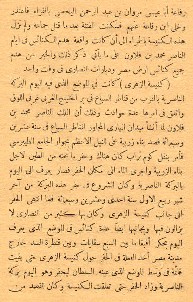
To next page
Al Maqrizi Muhammad al-Husayni al-Din al Maqrizi (1441)
In: Kitab al-Khitat (book of plans) from Iran
------------------------------------------------
Taken from: Neville Chittick; East Africa and the Orient
Marcel Devic: le Pays des Zendjs
N. Levtzion and J.F.P.Hopkins; Corpus of early Arabic Sources for West
African History.
The appendices on the translation by Gaudefroy Demombynes on the book
Masalik el absar fi mamalik el amsar by al-Umari
Youssouf KamaltomIIIfasc2
Memoires geographiques et historiques sur l'Egypte, et sur quelques contrees voisines....
Full name of the book: al-Mawa'iz wa al-'i' tibar bi dhikr al-khitat wa al-'athar (about Cairo)
Inserted in the middle of Ibn Salim's account of Nilotic Sudan (which has been preserved by Maqrizi) is a passage concerned with the sea route to Quanbalu. Although displaced and difficult to interpret, it seems reasonable to suppose that it derives from Ibn Salim, who went on a mission to King George of Maqurra in AD 969. It says nothing about Quanbalu itself except that it is in the country of the Zanj and is the city of their ruler. The route is clearly to Bilad az Zanj, through the text seems distorted, but one can confirm its relevance to this coast by reference to such sailing indications as those given for a journey to East Africa by Al Hamdani (945)
This is the text as given by Marcel Devic:
Travelers who visited the land of the Zendjs gave me the details of the road they keep to get there. They sail on the Sea of China, with the help of the northern wind, close to the continental shore of the peninsula of Egypt till they reach the place they call Ras Djafari, which they see as the end of the peninsula of Egypt. From there keeping there eyes on a star that will guide them they go towards the west, then they turn right to the north and follow constantly that direction till they reach Qabila, the capital of the Zendj. From thence they turn towards Djidda in their prayers. Some of these four rivers (of this geographical section), says Selym, come from the country of the Zendj, because the zendj wood is floated down by them.
Another maybe useful piece in Maqrizi's work is:
I've had the occasion says Abdallah d'Assouan, to see many people from different tribes in the region of the upper Nile. Most of them recognize a God creature and ask him for help through the intermediary of the moon, sun, or stars. Others do not believe in God and pray to the sun or the fire, others a tree, an animal, everything that fits them.
The races of the Sudan:
Be it known to you that the Sudan are the people of the Second Clime and what lies beyond it as far as the farthest part of the first, or rather the end of the inhabited world. They are continuous from west to east for they lie against the land of the Berbers in the Maghrib and Ifriqiya and the lands of the Yemen and the Hijaz and Basra and the lands of India which lie beyond those (in the east) . They are of various kinds (sinf), branches (sha'b) and tribes (qabila). The best known in the east are the Zanj, the Habasha, and the Nuba.
The Habasha are the offspring of habash b. Kush b. Ham, the Nuba are the posterity of Nuba b. Kush b. Kan'an b. Ham, and the Zanj are the offspring of Zanji b. Kush and that all the other blacks are descendents of Fut ben Ham. Theit tribes are 19 in number.
The Zenj live on the coast of the Indian sea, they have a town called Mombassa, they are mages (fire worshippers) and under the caliph d'El Mo'tamid, they revolted in Basra with the da'i (chiite). After that is Berbera. Islam is common among its citizens. They have a town Magadiso, on the Indian ocean. In the south east live the Demdem who are completely naked. They have invaded the land of the Nubiens and the Abyssins, at the same moment when the Tatars invaded Iraq. They destroyed a lot and then returned home.
Their neighbors are the Abyssins who are the most important people among the blacks. They are close to Yemen, on the shores of the western sea. They are Christians.
North of the Zendj and the Abyssins are the tribes of the Beja who are Christian or Muslim, and who possess the island of Souakin.
Kenan, the son of Ham, married Arteyt, the daughter of Benawyl Ibn Ters Ibn Yafeth. She gave birth to Haka and El Asawed, and the Nouba, and Koran, and Zendj, and Zaghawa, and all the tribes of the negroes.
They had bought them in Egypt when the precious objects were sold that were found in the palace of the Caliph (Mostanser)
Other coffers in big amounts who contain inkpots of different forms, round and square, small and big, gold, silver, sandal wood, aloes, ebony from Zindjes, ivory and wood of all kinds, enriched with stones, gold, silver or remarkable by the perfection and the elegance of the work.
-------------------------------------------------------------------------------------------------------------------------------
Maqrizi: An Niza wa't-Takhasum
Taken from: Int. Journal of Afr. hist. studies 1980
He mentions 4000 Zanj troops in Mosul (in 750 AD)
------------------------------------------------------------------------------------------------------------
Maqrizi: Historia Abessiniae
Taken from: William Desborough Cooley ; Claudius Ptolemy and the Nile: Or, An Inquiry Into that Geographer's Real ...
In the sea of the zanj there is a great island named al-komr, the inhabitants of which migrated to the opposite mainland, gave the same name (Komr) to the mountains near which they settled.
He also mentions the Gibbel al Kamar: Mountains of the Moon
---------------------------------------------------------------------------------------------------------------
Maqrizi: History of Egypt
Taken from: Revue de L�Orient latin; Histoire d�Egypte de Makrizi
In those days the World was divided into 5 empires �.Persians �Rum �Turks � India �China. As to the sons of Cham, Abyssins, Zendjs et Berbers they did not have a kingdom worth talking about.